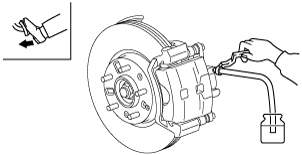 |
am6zzw00000789
AIR BLEEDING
id041100800200
1. Remove the bleeder cap and attach a vinyl tube to the bleeder screw.
2. Place the other end of the vinyl tube in a clear, fluid-filled container.
3. One person should depress the brake pedal a few times, and then hold it in the depressed position.
4. A second person should loosen the bleeder screw, drain out the fluid and close the screw using a commercially available flare nut wrench.
am6zzw00000789
|
5. Repeat steps 3 and 4 until no air bubbles are seen.
6. Bleed air from each component by following the procedure above.
7. After air bleeding, check the following: